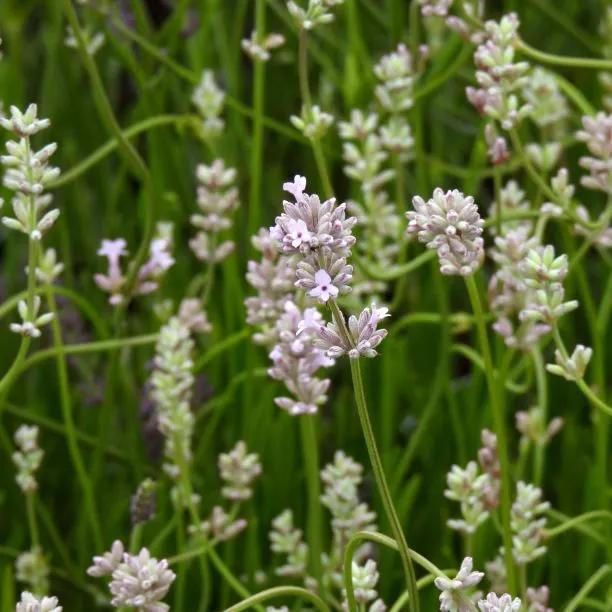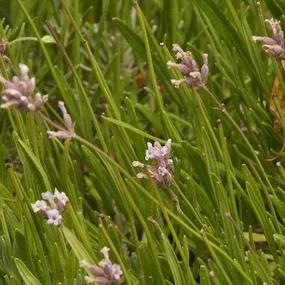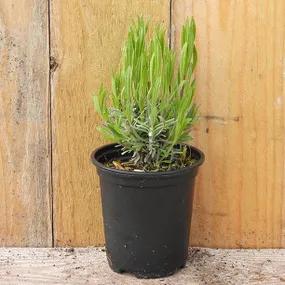'Loddon Pink' English Lavender Plants
Honest Delivery PricesPale Pink English Lavender
- Use: Low hedging / edging, basic topiary balls & shapes
- Flowers: Very pale pink spikes
- Flowering: July to September
- Scent: Strong, lavender
- Leaves: Evergreen, aromatic. Greener than most others
- Height x Spread: 60cm x 60cm
- Unappealing to deer, rodents
- Drought tolerant when established
- Culinary herb
- RHS Plants for Pollinators
Recommended extras
Description
Lavandula angustifolia 'Loddon Pink', English Lavender Plants
This English lavender has dainty, pale pink flowers that stand out against the green, aromatic foliage, which is much less silvery-grey than most other varieties.
Browse our varieties of lavender.
Delivery season is weather dependent. There is no point planting lavender out before nighttime temperatures rise as the shock sets it back, so it establishes slower than lavender planted later when the soil is warm.
- The smallest lavenders, in P9 pots, are never shipped before May.
- We aim to ship the larger pot sizes from the end of April, but cold weather can delay delivery into May.
Features
- Use: Low hedging / edging, basic topiary balls & shapes
- Flowers: Very pale pink spikes
- Flowering: July to September
- Scent: Strong, lavender
- Leaves: Evergreen, aromatic. Greener than most others
- Height x Spread: 60cm x 60cm
- Unappealing to deer, rodents
- Drought tolerant when established
- Culinary herb
- RHS Plants for Pollinators
Growing Loddon Lavender
- Aspect: Full sun, South facing
- Soil: Well drained is vital, poorly fertile is preferable
- Soil pH: Above 6.5 is best. Likes chalk
- Hardiness Rating: H5 (to -15C)
- Suitable for the coast and windy locations
- Ideal for container growing
Lavender must have good drainage and close to full sun. It prefers poor soil and thrives in exposed coastal sites.
When established, they are drought-tolerant, but in their first and second year you must water them well, as with any new shrub.
Don't plant lavender out too early in Spring: the cold soil will shock it and set it back. In most years, this means waiting until May.
There are different approaches to pruning, which is necessary to keep your lavender dense and beautiful.
The essential thing is to cut all the new, green growth down to two or three buds typically in early September, around when the last flowers have faded.
A light trim in Spring is optional, but recommended.
Spacing a Loddon Lavender hedge: Like most formal hedging, plant at 3 per metre, 33cm apart in a single row.
Deer and rodents are not interested in lavender - they might nibble fresh green Spring growth to test it, but as the foliage matures they ignore it.
Planting Instructions
Read our full guide on how to grow lavender, with a quick pruning video.
- Good drainage is most important: Lavender tolerates cold weather, but it hates "wet feet" in winter.
- Heavy clay on a dry, sunny hill that sheds water should be fine, but light, dry, poorly fertile soils are ideal.
- If your site is not well drained, lavender thrives in pots.
- It needs plenty of sun to flower well.
- It can grow near the sea, good for windy sites.
- It's drought resistant after it has established deep roots, which takes a couple of years.
Prepare the Soil Before Planting
- The key is to remove weeds and to break up soil compaction, so the new roots can spread out rapidly downwards and sideways.
- Don't enrich the soil, only use Rootgrow mycorrhizae at planting time.
- To improve drainage, it helps to raise the soil level a little by forking in plenty of grit and sharp sand, however, this is not usually practical beyond a small ridge or mound: growing Lavender in a pot is much easier than raising the level of a whole bed!
Care for Your New Lavender Hedge
- Most important: water thoroughly in dry weather for the first growing season. Soak the ground, and then let the soil almost dry out before watering again.
- Second most important: weed around the plants.
After the first growing season, lavender in most gardens should never need watering again.
If your soil is very dry and sandy, then continue to water in dry weather at the start of their second growing season.
Even with the best care, all lavender hedging tends to go woody and floppy after 10-15 years, losing its full appeal. When you see this happening, take cuttings to replace the old hedge, or order new ones from us.
Trimming Lavender Plants
A hard trim every year in late autumn ensures dense growth, more flowers, and extends Lavender's ornamental life span.
Cut back each stem to about two buds / 2cm of green growth.
- Avoid cutting into the older, woody part of the stems: if you prune yearly, you should never need to do this.
Deadhead flowers regularly to encourage more - it's up to you to decide whether to leave the last blooms on the plants overwinter.
Hygiene & Diseases
Lavender is very disease resistant, and diseases are typically indicators that the site is too damp and/or shady for Lavender to thrive.
- Prune off Dead, Damaged or Diseased (DDD) wood as soon as it appears.
- Disinfect your pruning tools between every cut if there are signs of disease.
- Disposing of diseased material is safer than composting it.
- Clean out Autumn leaves from underneath your plants, which can trap damp.
Did you know?
Dating back to the first half of the 20th century, it is not from Loddon, near Norwich, but the former Loddon Nurseries, which used to be near Reading and the river Loddon. The most likely breeder would have been long term owner, Thomas Carlile.




